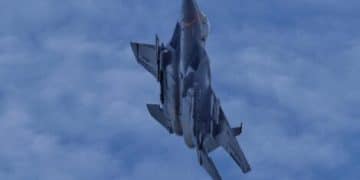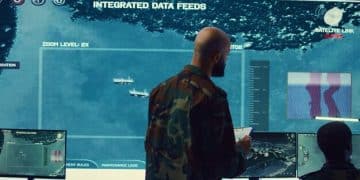US Military Radar: Newest Advancements & Future Tech

The latest advancements in US military radar technology are revolutionizing situational awareness, primarily through GaN-based AESA systems, AI-driven processing, and enhanced stealth detection capabilities, fundamentally reshaping modern warfare and defense.
Exploring what are the newest advancements in US military radar technology reveals a dynamic landscape where innovation meets necessity. From enhancing detection capabilities to adapting to evolving threats, radar systems are at the forefront of military defense. This article delves into the cutting-edge developments shaping the future of US military radar.
the Evolution of Radar Technology in Military Applications
The origins of radar technology trace back to the early 20th century, primarily as a means for detecting distant objects. Its military application was quickly recognized, playing a pivotal role in World War II for air and sea surveillance. Initially, these systems were bulky and limited in their capabilities, often relying on basic pulse-echo principles.
Over decades, radar evolved significantly. The advent of solid-state electronics, digital processing, and miniaturization techniques transformed these formidable machines into more compact, versatile, and precise instruments. Early advances focused on increasing range, improving target discrimination, and enhancing resistance to jamming. The Cold War era saw a significant push towards developing over-the-horizon radars and improved airborne interception systems. This historical progression laid the groundwork for today’s sophisticated radar networks, which are integral to modern military operations. The continuous development has been driven by the need to counter increasingly stealthy threats and operate effectively in complex electromagnetic environments.
From Analog to Digital: A Paradigm Shift
The transition from analog to digital processing marked a watershed moment in radar technology. Analog systems were prone to noise, limitations in signal processing, and a lack of flexibility. Digitalization brought unprecedented improvements.
* Improved signal clarity and processing speed.
* Enhanced capabilities for filtering clutter and noise.
* Greater flexibility in adapting to different operational modes.
* Seamless integration with other digital combat systems.
This digital transformation allowed for more complex algorithms and computational power, leading to advancements such as synthetic aperture radar (SAR) and inverse synthetic aperture radar (ISAR), providing highly detailed imagery regardless of environmental conditions.
The shift also facilitated the development of multi-function radars, capable of performing surveillance, tracking, and targeting simultaneously. This enhanced versatility significantly improved the operational efficiency and tactical advantage of military platforms, reducing the need for multiple, specialized radar units. These digital systems also enhanced the ability to differentiate between various types of targets, from small drones to cruise missiles, providing critical intelligence for decision-making.
Gallium Nitride (GaN) and Active Electronically Scanned Arrays (AESAs)
At the forefront of modern radar advancements are Gallium Nitride (GaN) technology and Active Electronically Scanned Arrays (AESAs). These two technologies are synergistic, with GaN significantly enhancing the performance of AESA systems, leading to more powerful, efficient, and versatile radar capabilities.
AESAs represent a fundamental shift from traditional mechanically scanned arrays. Instead of a single transmitter/receiver, an AESA comprises thousands of tiny transmit/receive (T/R) modules, each capable of independently emitting and receiving radar signals. This allows for instantaneous beam steering, enabling multiple functions simultaneously, such as tracking numerous targets while also performing surveillance or electronic warfare. GaN, a semiconductor material, provides superior power efficiency, higher power output, and better thermal management compared to older materials like Gallium Arsenide (GaAs). When integrated into AESA T/R modules, GaN boosts the radar’s range, resolution, and resistance to electronic countermeasures.
The Advantages of GaN in AESA Radars
GaN technology is revolutionizing AESA radar performance, offering a suite of advantages that were previously unattainable. The ability of GaN to operate at higher temperatures and voltages allows for more compact and powerful radar designs.
* Increased Power and Range: GaN enables T/R modules to output significantly more power, extending detection ranges and improving target acquisition.
* Enhanced Efficiency: Higher power efficiency means less waste heat and lower power consumption, crucial for extended missions and platform integration.
* Compact Size and Weight: The superior thermal properties and power density of GaN allow for smaller, lighter radar arrays, suitable for a wider range of platforms including UAVs and smaller naval vessels.
* Improved Reliability: GaN devices are inherently more robust and have a longer lifespan, reducing maintenance requirements and increasing operational readiness.
These benefits translate directly into superior surveillance capabilities, more accurate targeting, and enhanced survivability for military assets. The reduced footprint also means more space for other critical systems, optimizing overall platform design. GaN also contributes to the longevity of the radar system, enduring the harsh conditions often encountered in military operations.
Real-world Applications and Impact
GaN-powered AESA radars are being deployed across various US military domains, from airborne platforms to naval vessels and ground-based systems. Their impact on battlefield superiority is profound. For instance, the US Air Force’s F-35 fighter jets utilize advanced AESA radars that benefit from GaN technology, providing unparalleled situational awareness. On naval warships, GaN-based radars enhance multi-mission capabilities, simultaneously tracking air and surface threats.
These advancements improve the detection of stealth aircraft and missiles, providing earlier warning and engagement opportunities. They also contribute to more effective electronic warfare, allowing radars to operate in highly contested electromagnetic environments where adversaries are attempting to jam or spoof signals. This technological leap ensures that US forces maintain a decisive advantage in sensing and situational awareness across all operational theaters. The continuous integration of GaN is a testament to its transformative potential in military radar.

AI and Machine Learning Integration in Radar Systems
The integration of Artificial Intelligence (AI) and Machine Learning (ML) into military radar systems marks a pivotal advancement, transforming how data is processed, interpreted, and utilized. These technologies move beyond traditional signal processing, enabling radars to learn, adapt, and make more intelligent decisions autonomously.
AI and ML algorithms are applied to a vast array of radar functions: target classification, clutter rejection, anomaly detection, and even predictive maintenance. By analyzing massive datasets of radar returns, these algorithms can discern subtle patterns that human operators might miss, significantly enhancing the accuracy and reliability of target identification, especially in crowded or noisy environments. This capability is crucial for differentiating between friendly and hostile forces, or between genuine threats and atmospheric disturbances.
Intelligent Target Classification and Tracking
One of the most significant impacts of AI/ML in radar is on intelligent target classification and tracking. Earlier radar systems relied on predefined parameters to identify targets, which often led to false positives or difficulty in classifying novel threats.
* Improved Classification Accuracy: AI algorithms can analyze complex radar signatures to accurately classify targets, distinguishing between different types of aircraft, missiles, drones, and even ground vehicles.
* Adaptive Tracking: ML models enable radar systems to adapt their tracking algorithms in real-time based on target behavior, maintaining lock even in evasive maneuvers or complex trajectories.
* Reduced Operator Workload: By automating many classification and tracking tasks, AI reduces the cognitive load on human operators, allowing them to focus on high-level decision-making.
This intelligent automation reduces the time between detection and engagement, a critical factor in high-speed, dynamic combat scenarios. The ability to quickly and accurately identify a threat means earlier and more effective response. AI’s continuous learning capability also ensures that radar systems evolve with new threats, improving over time without constant manual reprogramming.
Enhanced Electronic Warfare Capabilities
AI and ML are also bolstering electronic warfare (EW) capabilities, allowing radar systems to operate more effectively in environments saturated with electronic countermeasures. Traditional EW responses were often reactive and limited by pre-programmed counter-measures.
AI-driven EW systems can:
* Automatically identify and classify unknown jamming signals.
* Adaptively change radar parameters (e.g., frequency, pulse repetition interval) to overcome jamming.
* Predict adversary EW tactics based on observed patterns.
* Optimize radar emissions to minimize detection by adversary sensors.
This proactive and adaptive approach provides a significant advantage in electronic warfare, enabling US military radars to maintain operational effectiveness even when faced with sophisticated jamming techniques. The ability of AI to learn from new EW threats and rapidly develop counter-strategies is invaluable in maintaining spectrum dominance. Machine learning plays a crucial role in predicting and mitigating potential signal interference, ensuring continuous, reliable operation.
Stealth and Counter-Stealth Technologies
The ongoing arms race between stealth technology and counter-stealth measures is a defining feature of modern military radar development. As adversaries develop more effective stealth aircraft and missiles designed to evade detection, the US military is investing heavily in technologies to counter these low-observability threats.
Stealth technology works by minimizing an object’s radar cross-section (RCS) through shaping, specialized materials, and active cancellation. Counter-stealth radar research focuses on developing systems that can detect these reduced-RCS targets. This includes advancements in bistatic and multistatic radar, low-frequency radars, and quantum radar concepts, all designed to overcome the limitations of traditional monostatic radar against stealth. This constant innovation is critical to maintaining a defensive edge and ensuring the ability to identify and track any potential threat.
Low-Frequency and Multi-Static Radar Architectures
One promising avenue for counter-stealth is the use of low-frequency radar and multi-static architectures. Traditional stealth designs are optimized to reduce reflections at higher frequencies, common in modern fire-control radars.
* Low-Frequency Radars: Longer wavelengths of low-frequency radars (e.g., UHF, VHF bands) interact differently with stealthy aircraft, often causing resonant effects that lead to larger radar returns, making detection easier.
* Multi-Static Radar: Instead of a single transmitter and receiver in the same location (monostatic), multi-static systems use geographically separated transmitters and receivers. This approach exploits the fact that stealth designs are optimized to deflect radar waves away from the transmitting source, but not necessarily away from multiple, distributed receivers.
By triangulating signals from multiple receivers, multi-static radars can construct a more complete picture of a target, even one with a low RCS. This distributed approach makes them inherently more resilient to jamming and provides a more robust detection capability against stealth targets. The diverse angles of illumination and reception create more opportunities for detection, overcoming the limitations of single-point observation.
Quantum Radar and Novel Detection Concepts
Beyond current operational systems, research into novel detection concepts like quantum radar represents the cutting edge of counter-stealth. While still largely theoretical or in early experimental stages, these concepts hold enormous potential for future detection capabilities.
Quantum radar, for example, seeks to exploit quantum mechanics principles, such as entanglement, to detect targets with unprecedented sensitivity. The idea is that entangled photons could be used to probe for targets, and even if some are lost, the remaining entangled pair could still provide information about the target’s presence, theoretically bypassing traditional stealth measures. While the engineering challenges are immense, such research demonstrates the continuous push to explore radically new physics for military application. Other novel concepts include passive coherent location (PCL) systems that leverage existing ambient radio signals (e.g., TV, radio broadcasts) for detection, offering a truly “emission-free” radar capability that is difficult to detect or jam. These advanced concepts could redefine the boundaries of future military surveillance.
Miniaturization and Networked Radar Systems
The trend towards miniaturization and the development of highly networked radar systems are transforming the deployment and effectiveness of military radar. Smaller, lighter radar components mean that advanced capabilities can be integrated into a wider array of platforms, including small unmanned aerial systems (UAS) and agile ground vehicles.
Networked radar, often referred to as “sensor fusion” or “net-centric warfare,” involves linking multiple geographically dispersed radar sensors and other intelligence sources into a cohesive network. This creates a much more robust and comprehensive picture of the battlespace than any single radar could provide. Data from various sensors are fused and analyzed in real-time, resulting in improved target tracking, extended coverage, and enhanced resilience against electronic attacks or physical damage to individual sensors. This approach maximizes the overall utility and impact of disparate radar assets.
Radar on Small Platforms and UAVs
The miniaturization of radar components has opened up new possibilities for integrating advanced sensing capabilities onto small platforms and unmanned aerial vehicles (UAVs). Traditionally, high-performance radars required substantial power and space, limiting their deployment to larger aircraft or ground installations.
Now, compact GaN-based AESA radars can be fitted onto:
* Tactical UAVs: Providing persistent surveillance, targeting, and intelligence, surveillance, and reconnaissance (ISR) capabilities in contested environments.
* Small Ground Vehicles: Enhancing situational awareness for ground forces, detecting threats like small drones or short-range rockets.
* Even Individual Soldiers: Portable radar systems for perimeter security or target location.
This widespread distribution of radar sensors enhances battlefield awareness at all echelons, from strategic to tactical. The ability to deploy radar into environments previously unreachable for larger systems provides critical new intelligence streams. Miniaturization allows for discreet and agile deployment, offering unprecedented flexibility in gathering critical data.
Distributed Aperture and Sensor Fusion
Networked radar systems truly come into their own with the concepts of distributed aperture and sensor fusion. Instead of relying on one large, powerful radar, distributed aperture systems use multiple smaller, geographically separated radar nodes that act as one large, virtual antenna.
The benefits include:
* Enhanced Resolution and Accuracy: The combined data from multiple nodes can synthetic aperture radar (SAR) techniques to create extremely high-resolution images, exceeding what a single radar could achieve.
* Improved Resilience: If one node is damaged or jammed, the network can continue to function, providing a robust and fault-tolerant system.
* Wider Coverage: Geographically distributed nodes can cover a much larger area, eliminating blind spots and improving persistent surveillance.
* Better Stealth Detection: Multi-static geometry, inherent in distributed systems, offers advantages against stealth targets.
Sensor fusion integrates data not just from multiple radars, but from diverse sensor types (e.g., optical, infrared, electronic intelligence) to build a truly comprehensive, multi-spectral common operating picture. This fusion reduces ambiguity, improves target identification, and provides a level of situational awareness previously impossible. The interconnectedness of these systems multiplies their individual capabilities.
Future Trends and Challenges in US Military Radar
Looking ahead, the future of US military radar technology promises continued innovation, driven by evolving threats and the relentless push for technological superiority. However, this path is not without its challenges, requiring strategic investment and adaptiveness.
Key future trends include further integration of cognitive radar principles, enhanced cyber resilience, and the development of multi-domain multi-function sensors. Cognitive radar aims to make systems even more autonomous and intelligent, capable of learning from their environment and optimizing their performance in real-time, potentially even anticipating adversary moves. Cyber resilience is paramount, as sophisticated adversaries increasingly target networked systems to disrupt, degrade, or deceive. The ultimate goal is to move towards true multi-function sensors that seamlessly integrate radar, electronic warfare, and communications into single, highly versatile systems.
Cognitive Radar and Adaptive Sensing
Cognitive radar represents a significant leap from current AI-augmented systems. While current AI helps radar process data, cognitive radar seeks to build systems that learn proactively and adapt their sensing strategies.
This involves:
* Real-time Environment Awareness: Radars that can “understand” their surrounding electromagnetic environment, including clutter, noise, and adversarial jamming attempts.
* Adaptive Waveform Generation: Dynamically changing transmitted waveforms to optimize for specific targets or environmental conditions.
* Predictive Analytics: Anticipating target behavior or adversary EW tactics and adjusting radar operations accordingly.
* Autonomous Optimization: The radar system continually refines its own parameters to maximize performance against specific threats, rather than relying on pre-programmed modes.
The goal is a radar that doesn’t just react to the environment but actively shapes its interaction with it, making it incredibly difficult for adversaries to predict or counter. This capability ensures that the radar maintains optimal performance across diverse operational scenarios, providing unprecedented agility.
Cyber Security and Electronic Hardening
As radar systems become more networked and digitally advanced, they also become more vulnerable to cyberattacks. Ensuring the cyber security and electronic hardening of military radar is a critical challenge. Adversaries could seek to:
* Insert Malicious Code: Compromising radar software to provide false targets, hide real ones, or disrupt functionality.
* DDoS Attacks: Overwhelming radar communication links or processing capabilities.
* Spoofing and Deception: Sending false radar returns or altering legitimate ones to confuse operators.
To counter these threats, future radar development heavily emphasizes secure hardware, robust encryption protocols, intrusion detection systems, and resilient network architectures. Electronic hardening, encompassing measures against EMP (electromagnetic pulse) and high-power microwave attacks, also remains crucial for protecting physical infrastructure and ensuring operational continuity in harsh environments. The integrity and reliability of radar data are paramount for effective decision-making.

Hypersonic Threat Detection
The emergence of hypersonic weapons, capable of maneuvering at speeds exceeding Mach 5, presents a formidable challenge for existing radar systems. Detecting, tracking, and intercepting such threats requires a new level of radar performance.
Current radar systems often struggle with the extreme speed, high altitude, and unpredictable trajectories of hypersonic missiles. Future radar advancements must focus on:
* Increased Update Rates: Rapidly refreshing target data to track fast-moving objects.
* Enhanced Sensitivity and Resolution: Detecting smaller, less reflective hypersonic Glide Vehicles.
* Advanced Tracking Algorithms: Reliably predicting the path of maneuverable hypersonic threats.
* Layered Sensor Networks: Combining ground, air, and space-based radar assets to provide continuous “custody” of hypersonic targets.
Meeting the hypersonic challenge will likely involve a combination of existing radar technologies pushed to their limits, coupled with novel approaches and heavy reliance on AI-driven data fusion across a globally distributed network of sensors. This represents one of the most pressing drivers for radar innovation in the coming decade.
| Key Radar Advancements | Brief Description |
|---|---|
| 💡 GaN & AESA Systems | Gallium Nitride greatly boosts AESA radar power, efficiency, and range for superior detection. |
| 🧠 AI/ML Integration | AI and Machine Learning enhance target classification, tracking, and electronic warfare capabilities. |
| 👻 Counter-Stealth Tech | Low-frequency, multi-static, and quantum concepts emerge to detect stealthy threats. |
| 🔗 Networked Radar | Miniaturization allows wide deployment; sensor fusion creates robust, comprehensive situational awareness. |
Frequently Asked Questions About US Military Radar
AESA stands for Active Electronically Scanned Array. It’s crucial because it uses thousands of small transmit/receive modules to steer radar beams instantaneously without mechanical movement. This allows for simultaneous multi-functionality, such as tracking multiple targets while scanning for new ones or engaging in electronic warfare, significantly enhancing situational awareness and combat effectiveness.
GaN is a semiconductor material that enables radar systems to generate higher power output with greater efficiency and better thermal management. Integrating GaN into AESA modules results in radars with extended range, improved resolution, reduced power consumption, and a smaller, lighter footprint. This makes high-performance radars deployable on a wider array of military platforms.
AI and Machine Learning are integrating into radar systems to enhance data processing, target classification, and electronic warfare. AI algorithms can identify subtle patterns in radar returns, differentiate between targets, and adapt to jamming signals in real-time. This reduces operator workload, improves accuracy, and allows radars to learn and optimize their performance autonomously against evolving threats.
To counter stealth, US military radar development focuses on low-frequency radars that exploit wavelength interactions with stealth designs, and multi-static radar architectures that use geographically separated transmitters and receivers. Concepts like quantum radar are also being researched for unprecedented sensitivity. These approaches aim to detect targets that are optimized to avoid traditional monostatic, high-frequency detection.
Future challenges include enhancing cyber security against sophisticated digital attacks and effectively detecting hypersonic threats. As radars become more networked and intelligent, protecting them from disruption or deception is vital. Detecting and tracking hypersonic weapons, with their extreme speed and maneuverability, also demands significant advancements in radar update rates, sensitivity, and predictive tracking algorithms.
Conclusion
The relentless pursuit of innovation defines the trajectory of US military radar technology. From the transformative power of GaN-enhanced AESA systems to the intelligent integration of AI and the innovative approaches to counter stealth, these advancements underscore a commitment to maintaining a decisive technological edge. As new challenges emerge, particularly in the realm of hypersonic threats and electronic warfare, the adaptability and resilience of these evolving radar systems will prove critical in shaping future defense capabilities and ensuring national security.





